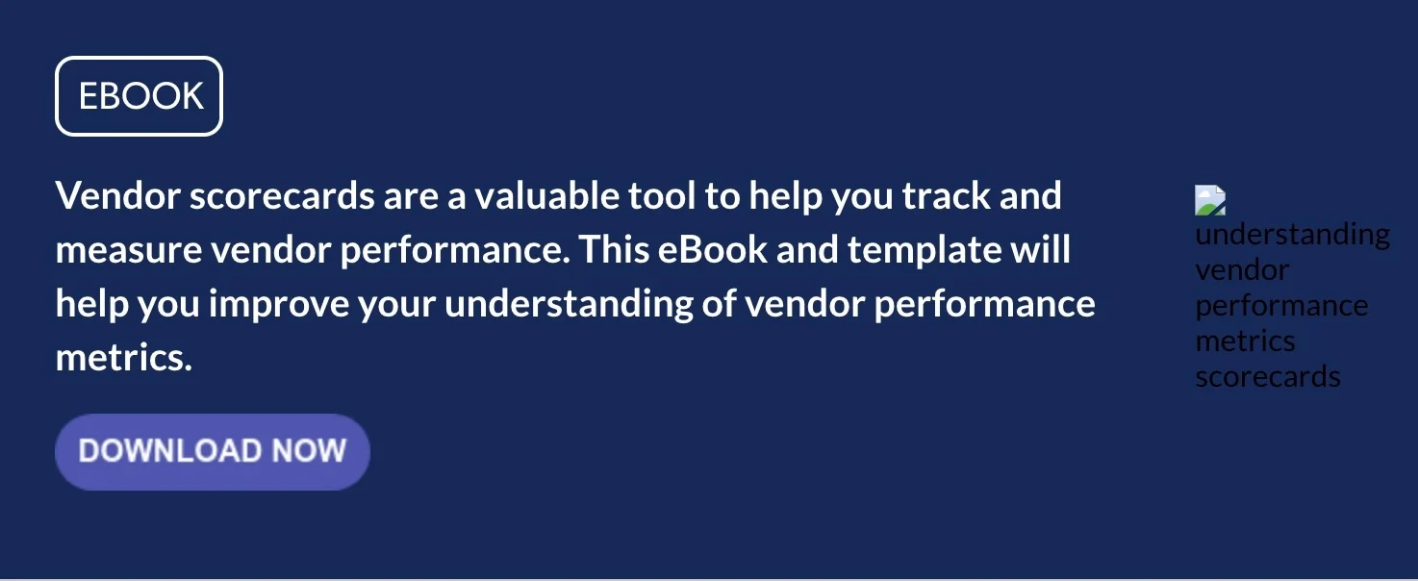Organizations often use third-party vendors to improve operations and address gaps in areas such as capacity, expertise, and security. In other cases, vendors produce products and services that help organizations realize an opportunity to increase market share, drive revenue, or acquire new customers. In fact, the use of third-party vendors has become a key part of a larger business strategy to help your organization meet its various business needs and achieve its objectives. So, it's important to monitor vendor performance to ensure that the intended value of the relationship is delivered.
Vendor performance metrics make it possible to quickly determine if the vendor is performing as it should or if there are any issues. Consider the old adage: "the measurement is only as good as the ruler," which perfectly applies to vendor performance. Your organization can measure vendor performance more effectively if it has the right metrics.
But, what are the right vendor performance metrics? How are they used? And, how do these metrics inform your organization's business decisions?
Organizational Objectives, Goals, and Vendor Performance Targets
To develop the right vendor metrics, you must first identify which organizational goals and objectives are to be achieved through the vendor relationship. Why must your organization engage with the vendor? It’s important to identify exactly how the vendor relationship supports those goals and objectives.
For example, suppose your organization wants to improve its Net Promoter Score (NPS) and intends to achieve this, in part, by utilizing a new customer service call center. If "improving NPS scores" is the rationale for the vendor relationship, it’s also the overarching vendor performance target. That means each specific vendor performance metric should somehow relate to that vendor performance target.
Use Service Level Agreements to Reinforce Your Requirements
Most of us are familiar with the terms SLA or Service Level Agreement, but what are SLAs and how are they used? SLAs are a specific type of performance metric used to ensure that vendor performance does not fall beneath agreed-upon performance levels. They do the following:
- SLAs establish firm, legally-binding commitments between your organization and the vendor.
- These SLAs represent "non-negotiable" service requirements identified and outlined in your contract or written agreement.
- With SLAs, there is often a requirement for remedy or a stated penalty in case the vendor doesn't meet the commitment, such as a refund, service credit, or discount. Repeated SLA violations could result in the termination of the vendor. SLAs may also be used to incentivize vendors by offering a bonus or other benefit for excellent performance.
- The term "service level agreement" should be reserved for those business requirements formalized by a legal agreement.
Regarding the call center example above, the organization may implement service level agreements regarding the vendor's regulatory and legal compliance, protection of customer data, and customer-complaint tracking and resolution.

Use KPIs to Evaluate Performance from Different Angles
Key Performance Indicators, or KPIs, are performance metrics that help provide information on efficiency and success in meeting organizational goals or expectations. KPIs provide a comprehensive picture of a vendor's performance from multiple angles and are useful for identifying performance trends and opportunities.
Suppose that "improve NPS scores" is the vendor target. Your organization would need to identify KPIs that measure performance levels and behaviors in support of the target. Here are some examples:
For KPIs to be an effective part of vendor performance management, it’s essential to choose only those KPIs that are relevant to performance in support of the business objective. For a vendor that manages customer experience, for example, financial KPIs may not fully reflect customer satisfaction.
Utilizing Vendor Performance Scorecards
To get the most comprehensive view of the vendor's performance, vendor performance SLAs and KPIs are recommended to be consolidated into a vendor performance scorecard. Scorecards can provide a holistic look at performance without requiring the user to review individual reports or disparate data sets.
While scorecard formats can vary from organization to organization, some standard rules apply:
- Keep scorecard information brief and easy to digest. Adding features like color coding can assist in flagging action items or determining KPI status.
- Use language that is accessible and easy to use for all employees who will need to use the scorecard. The list of performance indicators does not matter if the tool is too cumbersome and difficult to use.
- Develop your scorecard in collaboration with the vendor. Review it together regularly
Effective third-party risk management includes robust vendor performance management and monitoring. That process begins by specifying how a vendor should support specific organizational goals and objectives. That is the first step for defining essential SLAs and the correct KPIs. Tracking vendor performance metrics with a vendor performance scorecard is a best practice that enables purposeful action and good business decisions based on vendor performance metrics.






.gif?width=1920&name=Sample-Graphic-Animation%20(1).gif)




